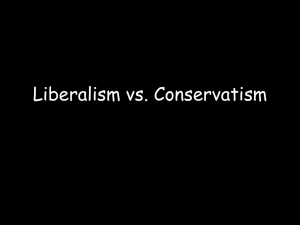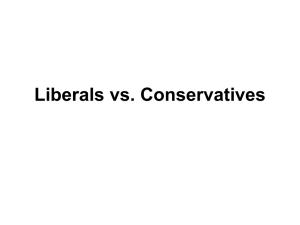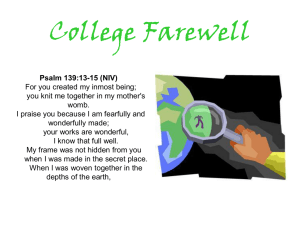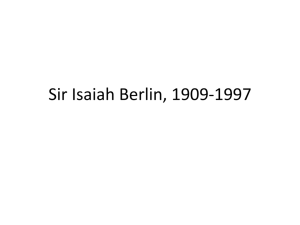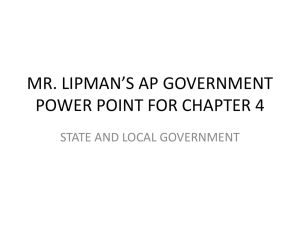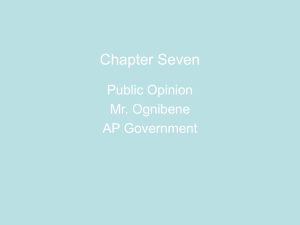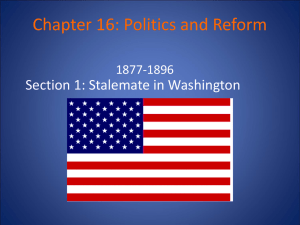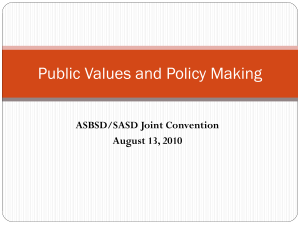The Nature and Functions of American Political Parties
advertisement
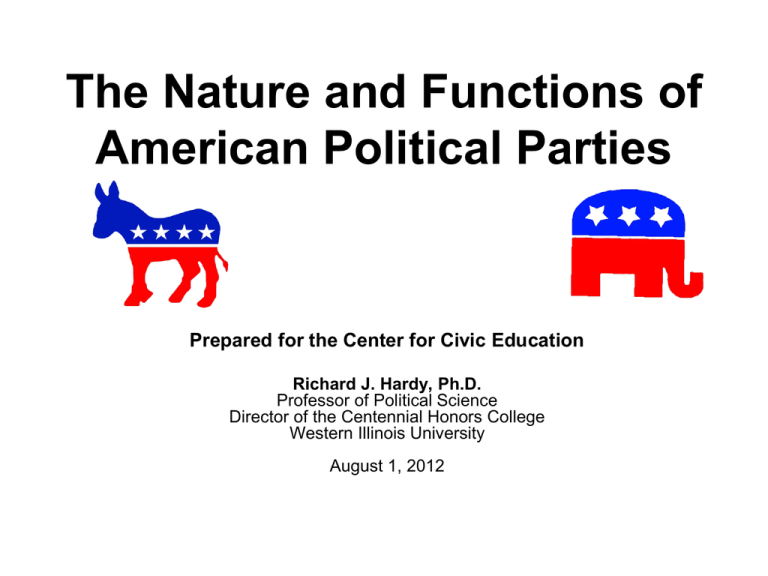
The Nature and Functions of American Political Parties Prepared for the Center for Civic Education Richard J. Hardy, Ph.D. Professor of Political Science Director of the Centennial Honors College Western Illinois University August 1, 2012 “No America without democracy, no democracy without politics, no politics without parties, no parties without compromise and moderation.” --Clinton Rossiter Topical Outline I. What Are Political Parties? A. Definition of Political Parties B. Classification of Political Parties 1. By Selection of Members 2. By Nature of Ideology 3. By Degree of Centralization 4. By Degree of Party Discipline What is a Political Party? Do You Think of Political Party Leaders? Do You Think of Political Party Symbols? Do You Think of Political Party Conventions? Do You Think of Political Campaigns? Do You Think of Divisions in Congress? Do You Think of Political Parties Positively? Do You Think of Political Parties Negatively? Definition • A political party is group of people who run candidates for public office under its banner. 1. By Selection of Members • Cadre Parties • Mass Parties Cadre Party Cadre refers to a nucleus or small core of indoctrinated leaders who promote ideological interests. Examples: Socialist Workers’ Party, American Nazi Party, Communist Party Mass Party Mass party refers to an organization where anyone is encouraged and free to join. There are few if any tests for membership. Examples: American Democratic and Republican Parties 2. By Nature of Ideology • Missionary Parties • Broker Parties Missionary Party Missionary party refers to a highly ideological organization whose members must be recruited and converted to the tenets or values of the organization. Examples: Prohibition Party, Communist Party Missionary Parties want Converts! Broker Party A Broker is someone who buys and sells on a commission. A broker party is an organization that is less ideological and is willing to modify its positions on issues in order to secure the most votes. Examples: American Democratic and Republican Parties Interest Groups Interest Groups Interest Groups Broker Parties Want VOTES! Ideology • Ideology is a systematic set of attitudes and opinions people use to justify their view of the political world. • There is no one ideology. • Ideology is thought to exist on a continuum from left to right on the political spectrum. N=Number Frequency Distribution High Low Low T=Trait Hig h N Men’s Shoe Size Range of Sizes 4 8 10 T 12 22 N 4 8 10 T 12 22 N 4 8 10 T 12 22 Statistical Normality “The Bell Curve” Grade Distribution N Class of 500 College Freshman F D C T B A N Standard Deviations from the Mean -2 -1 0 T +1 +2 N Law School Admissions Test (LSAT) -2 120 -1 0 +1 144 151 160 T +2 180 N Left Right Moderate Liberal Conservative Radical -1-2 Reactionary -1 -2 0 0 T +1 +1 +2 +2 -2 -1 0 +1 +2 N Moderate DEMOCRATS REPUBLICANS Liberal Conservative Radical -2 Reactionary -1 0 T +1 +2 N Moderate Liberal Conservative REPUBLICANS Radical Reactionary DEMOCRATS -2 -1 0 T +1 +2 -2 -1 0 +1 +2 -2 -1 0 +1 +2 -2 -1 0 +1 +2 -2 -1 0 +1 +2 What would happen if….? -2 -1 0 +1 +2 What would happen if….? -2 -1 0 +1 +2 What would happen if….? -2 -1 0 +1 +2 What would happen if….? -2 -1 0 +1 +2 Lesson “To win elections, candidates must play between the forty yard lines of the political football field.” 3. By Degree of Centralization • Highly Centralized (Unitary) • Highly Decentralized (Federal) Centralized Power Decentralized Power The American Democratic and Republican Parties are perhaps the most DECENTRALIZED political parties in the world! 4. By Degree of Discipline • Strong Party Discipline • Weak Party Discipline Strong Party Discipline Discipline refers to the degree of authority and power the leaders hold over their rank and file members. Parties with strong party discipline hold a great deal of leverage over party members. Examples: British Labour and Conservative Parties Weak Party Discipline Discipline refers to the degree of authority and power the leaders hold over their rank and file members. Parties with weak party discipline have relatively little leverage over party members. Examples: American Democratic and Republican Parties Democrats and Republicans • Mass Parties--virtually anyone can join • Broker Parties--looking for votes, not converts • Decentralized Parties--power is widely dispersed • Weak Party Discipline--leaders exert few sanctions Topical Outline II. What are the Functions of Political Parties? A. B. C. D. E. F. G. Promote stability Recruit leaders Organize government Help educate citizens Provide loyal opposition Spawn civic engagement Simplify choices A. Promote Stability Major political parties serve as a buffer to soften the class of extremism. They do so by building coalitions and brokering compromises. B. Recruit Leaders Modern governments need quality leaders. Political parties serve as personnel agencies to identify, recruit and promote competent public servants. C. Organize Government Without some mechanism to organize the lawmaking process, legislative bodies would be nearly impossible to function. Party leaders set legislative priorities and help enact laws. D. Help Educate Citizens Parties help define issues and educate voters about their positions on public policy. E. Provide Loyal Opposition The party out of power serves as watchdog to keep the governing party from abusing its authority. F. Spawn Civic Engagement Parties help register voters and organize get-out-to-vote drives. Voter turnout in partisan elections, all things being equal, is significantly higher than in non-partisan elections. G. Simplify Choices Most voters do not have the time, resources or inclination to study every candidate and issue. The parties help simplify their choices. Topical Outline III. Why A Two-Party System? A. B. C. D. E. Tradition Cultural Consensus Economic Divisions Political Socialization Legal Restrictions A. Tradition It seems the United States has nearly always had a strong twoparty system. It is part of our nation’s history and tradition. Development of the America’s Two-Party System B. Social Consensus If a nation can achieve a “consensus” on fundamental values, then two parties are all that is needed to resolve secondary issues. C. Economic Divisions Some believe our two major political parties represent an economic division between the so-called “haves” and “have nots” in American society. Development of the America’s Two-Party System D. Political Socialization The primary agent of partisan transmission is the family. Most American families are either identify with or lean to either the Democratic Party or the Republican Party. Few American children are socialized to be anything else. E. Legal Restrictions Most legal restrictions are imposed by the 50 state constitutions and legislation. Historically, state governments have enacted laws that favor the two major political parties. For most U.S. elections, political candidates are elected from single-member districts where the winner-takes all. Hypothetical State with 10 Single-Member Election Districts where the “Winner Takes All” Results Democrats send 7 Representatives to Congress Republicans send 3 Representatives to Congress Hypothetical State with 10 Representatives using Proportional Representation (PR) where seats are apportioned, at large according to the popular vote. Results Democrats = 50% of popular votes, 5 seats Republicans = 40% of popular votes, 4 seats Communists = 10% of popular votes, 1 seat Electoral College Map, 2008 E lecto ra l Co ll ege 201 2, by S tate and E lectors S tate Alaba m a Alas k a Ar izo na Ar k ansas Cali fo rnia C o lo rad o C o nnec t icu t Dela w a r e Fl o rida Ge o rgia Ha w aii Idah o Illin o is Indiana Iow a Kansas Kent u ck y L o uisiana M aine M ar y land M ass a chu s et ts M ich igan M inn e so ta M is sis sippi M is so u r i M o ntana Nebr a sk a Ne v ada Ne w Ha m p sh ire Ne w J er se y Ne w M exi co Ne w Y o rk N o rth C a ro lina N o rth Da k o ta Ohi o O k lah o m a Oreg o n Penns y lv ania Rh o de I sland S o uth Car o lina S o uth Da k o ta Tenn e ss ee Te x as Utah Ve r m o nt Virgi n ia Washingt o n W e st V irginia W isc o n s in W yo m ing Di s tr ic t o f Columbia* T O T A LS Nu m be r o f U .S . Rep r es ent a ti ve s 7 1 9 4 53 7 5 1 27 14 2 2 18 9 4 4 6 6 2 8 9 14 8 4 8 1 3 4 2 12 3 27 13 1 16 5 5 18 2 7 1 9 36 4 1 11 10 3 8 1 -- - - 435 Nu m be r o f U.S . S enat or s 2 2 2 2 2 2 2 2 2 2 2 2 2 2 2 2 2 2 2 2 2 2 2 2 2 2 2 2 2 2 2 2 2 2 2 2 2 2 2 2 2 2 2 2 2 2 2 2 2 2 ------ 100 Nu m be r o f El e ct o ral V ote s 9 3 11 6 55 9 7 3 29 16 4 4 20 11 6 6 8 8 4 10 11 16 10 6 10 3 5 6 4 14 5 29 15 3 18 7 7 20 4 9 3 11 38 6 3 13 11 5 10 3 3 538 A can dida te n e ed s 270 E le ct or al C ol leg e V o te s (m ajori ty ) to w in the Pre sid en cy . *The D istrict o f rd C ol um bi a is a w ar d ed 3 E le ct or al C ol lege vo te s b as ed o n th e 23 A men d men t to the U .S . C on stitut io n. Topical Outline IV. What Role do Third Parties Play in American Politics? A. B. C. D. Serve as Political Safety Valves Are Political Barometers of Change Are Source of Innovation Can Serve as Spoilers Source: Richard J. Hardy. Government in America. Boston: Houghton Mifflin, 1991. P. 275. A. Safety Valves Third or minor parties serve as safety valves to allow disenchanted Americans to vent their anger and blow off their political steam. B. Barometers of Change Third or minor parties are often barometers of change. A strong electoral showing by a third party sends a strong signal to the two major parties. They spawn action. C. Source of Innovation Third or minor parties are often often policy innovators. They often spawn ideas that are eventually adopted by the two major parties. D. Can Serve as Spoilers While third or minor parties may not win many votes, they can influence elections by preventing one of the major parties from scoring victory in close elections. Topical Outline V. What are the Differences between Democrats and Republicans? A. Differences in core membership B. Differences in public policy A. Differences in Core Party Identifiers Core Democratic support by race, religion, education, economic status and geography. Core Republican support by race, religion, education, economic status and geography. B. Differences in Public Policy Balancing Liberty (Freedom) with Equality. Balancing Liberty (Freedom) with Security (Order/Authority) Equality Liberty Liberty Security Equality Liberty “Should the Government Increase Taxes on the Wealthiest Americans?” Liberals Equality Conservatives Liberty “Should the Government Increase Taxes on the Wealthiest Americans?” Liberals—Yes Conservatives—No Liberals Equality Conservatives Liberty “Should the federal government guarantee all Americans health care?” Liberals—Yes Conservatives—No Liberals Liberty Conservatives Security “Should the Congress extend provisions of the Patriot Act? Liberals—No Conservatives—Yes Liberals Liberty Conservatives Security “Should the government de-criminalize the use of marijuana?” Liberals—Yes Conservatives—No Liberal Equality Liberal Liberty Conservative Liberty Conservative Security Equality Liberty Liberty Security Equality Liberty Security Equality Liberal Conservative Liberty Security Equality Liberal Conservative Liberty Security Equality Democrats Republicans Liberty Security “All generalizations are false, including this one.” --Mark Twain Topical Outline VI. What Does the Future Hold for Democrats and Republicans? Discussion Agree or Disagree? Comments? Observations? Questions? Suggestions? Predictions?
